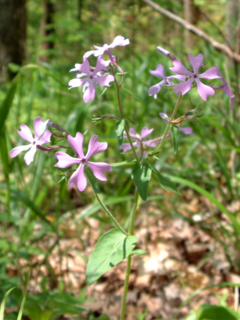Phlox divaricata
| Standard Cyclopedia of Horticulture |
|---|
|
Phlox divaricata, Linn. (P. canadensis, Sweet). Wild Sweet William. Fig. 2913. Sts. slender, pubescent, 10-18 in. tall: lvs. varying from linear-oblong to ovate- lanceolate, mostly acute: fls. in small cymes terminating short branches, 1 in. across, blue or pinkish blue, handsome and somewhat fragrant, the corolla-lobes often notched, the calyx-lobes narrow and subulate. Woods and copses, in lowish grounds. Que., west and south, to Fla. and La. B.M. 163. G.F. 7:256 (reduced in Fig. 2913). Gn. 60, p. 251; 76, p. 45. G.L. 18:335. G.W. 2, p. 655. R.B. 24:185. Gn.W. 23:433. Gn.M. 2:167.—A very attractive early spring fl., often coloring the floor of woods. Prefers rich soil. Var. Laphamii. Wood. Lvs. ovate: fls. bright blue; petals obtuse and entire. This name is listed abroad; plant said to be stronger-growing and with longer-blooming season than the species. G.M. 55:556.—P. divaricata has received considerable attention from cultivators abroad.
|
| Phlox divaricata {{{status}}} Fossil range: {{{fossil_range}}}
| ||||||||||||||||||||||||||||||||||||||||||||||||||||||||||||||||||
|---|---|---|---|---|---|---|---|---|---|---|---|---|---|---|---|---|---|---|---|---|---|---|---|---|---|---|---|---|---|---|---|---|---|---|---|---|---|---|---|---|---|---|---|---|---|---|---|---|---|---|---|---|---|---|---|---|---|---|---|---|---|---|---|---|---|---|
 | ||||||||||||||||||||||||||||||||||||||||||||||||||||||||||||||||||
| Plant Info | ||||||||||||||||||||||||||||||||||||||||||||||||||||||||||||||||||
| ||||||||||||||||||||||||||||||||||||||||||||||||||||||||||||||||||
| Scientific classification | ||||||||||||||||||||||||||||||||||||||||||||||||||||||||||||||||||
| ||||||||||||||||||||||||||||||||||||||||||||||||||||||||||||||||||
| [[{{{diversity_link}}}|Diversity]] | ||||||||||||||||||||||||||||||||||||||||||||||||||||||||||||||||||
| {{{diversity}}} | ||||||||||||||||||||||||||||||||||||||||||||||||||||||||||||||||||
| Binomial name | ||||||||||||||||||||||||||||||||||||||||||||||||||||||||||||||||||
| Phlox divaricata Sims | ||||||||||||||||||||||||||||||||||||||||||||||||||||||||||||||||||
| Trinomial name | ||||||||||||||||||||||||||||||||||||||||||||||||||||||||||||||||||
| {{{trinomial}}} | ||||||||||||||||||||||||||||||||||||||||||||||||||||||||||||||||||
| Type Species | ||||||||||||||||||||||||||||||||||||||||||||||||||||||||||||||||||
| {{{type_species}}} | ||||||||||||||||||||||||||||||||||||||||||||||||||||||||||||||||||
| {{{subdivision_ranks}}} | ||||||||||||||||||||||||||||||||||||||||||||||||||||||||||||||||||
| [[Image:{{{range_map}}}|{{{range_map_width}}}|]] | ||||||||||||||||||||||||||||||||||||||||||||||||||||||||||||||||||
| Synonyms | ||||||||||||||||||||||||||||||||||||||||||||||||||||||||||||||||||
| {{{synonyms}}} |
Phlox divaricata (Wild phlox, Wild blue phlox, Woodland phlox or Wild Sweet William) is a flowering plant in the genus Phlox. It is native to forests and fields in the eastern United States and Canada, ranging from Canada in the north, Florida in the south, Texas in the west and Quebec and New England in the east.
Wild phlox grows 25-50 cm tall with opposite, unstalked leaves 2.5-5 cm in length. The flowers are produced in early spring, 2-4 cm in diameter, with the five-lobed corolla a pale bluish violet or purple in color.